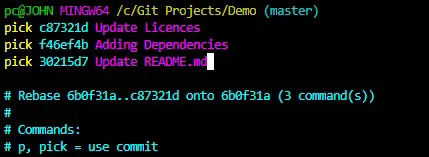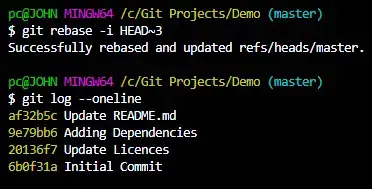Git push specific commits to remote repository
This article outlines the process of pushing a specific commit to a remote repository in Git. Suppose we have a Git repository with multiple commits, and we need to push only one commit, how would we go about it?
Push specific commits to the remote repository
To push a single commit to a remote repository, we use the Git push command in the context shown below.
$ git push <remote> <commit id>:<remote branch>
As always, we will use an example to illustrate this concept.
The example below shows a demo repository with four commits, as shown in the following image.

Let's say we want to push our initial commit to a remote repository. How would we go about doing this?
Assuming we are pushing to the remote repository for the first time, we will follow the steps below.
First, we add the remote repository to our local repository as shown below.
$ git remote add origin https://github.com/Wachira11ke/Demo.git
To push our initial commit to the remote, we will run:
$ git push origin 6b0f31a:refs/heads/master
Since we are pushing to the remote for the first time, we need to create a master branch in the remote repository using the refs/heads/master parameter. This command will only push our initial commits to the remote repository.
What if we only want to push the first commit, which is to update the license?
Running git push origin c87321d:masterwill not produce the expected effect.
This is because Git will push all commits up to and including the specified commit. We don't want that, do we?
We need to reschedule the submissions so that the first submission is the last. Our updated license submission should go immediately after the initial submission.
We can do this by running the git rebase command in interactive mode as shown below.
$ git rebase -i HEAD~3
This command will open a text editor. We will use the pick command and rearrange the commits as shown below.

We can now exit our text editor and complete the rebase. Your commit history should not look like this:

We can now push our commits to the remote repository as shown below.
$ git push origin 20136f7:master
Our remote repository should contain only two commits.
- Initial Submission Submission
- Update license submission.
Let's confirm our situation.

Together, git push <remote> <commit id>:<remote branch>this allows us to push specific commits to a remote repository.
However, this command will push all commits up to and including the specified commit. To fix this, you will need to use the git rebase command to rearrange your commits as we show.
For reprinting, please send an email to 1244347461@qq.com for approval. After obtaining the author's consent, kindly include the source as a link.
Related Articles
Git installation and establishment of local warehouse service
Publish Date:2025/04/05 Views:89 Category:Git
-
Git is a distributed version control system: the client does not only extract the latest version of the file snapshot, but also completely mirrors the original code repository. It has the following advantages: a. Since every extraction oper
git remote operation——multiple remote repositories for one project
Publish Date:2025/04/05 Views:131 Category:Git
-
Multiple remote repositories for a git project In our git project, the command to operate the remote repository information is $ git remote # 查看当前所有的远程仓库的名称 $ git remote -v # 查看远程仓库的名称和远程仓
Git cherry pick command usage
Publish Date:2025/04/05 Views:190 Category:Git
-
git cherry-pick is a powerful command that allows us to select an arbitrary Git commit by reference and attach it to the HEAD of the current working branch. Cherry picking is the act of picking a commit from one branch and applying it to an
Comparison between Git merge and Git rebase
Publish Date:2025/04/05 Views:171 Category:Git
-
The git rebase command may seem like Git wizardry to beginners, but if used carefully, it can actually make life easier for your development team. In this article, we compare git rebase with the related git merge command and identify all th
How to fix Git error Error: src refspec master does not match any
Publish Date:2025/04/05 Views:124 Category:Git
-
When using Git, we may encounter the error "src refspace master does not match any". Here's what the error means and how to fix it. What does src refspec master does not match any Mean in Git mean? We may encounter this error when we try to
Rebase local branch when pulling changes from remote repository branch in Git
Publish Date:2025/04/05 Views:144 Category:Git
-
This article will cover the basics of rebasing your local branch when pulling changes from a remote repository branch in Git. We use the version control system Git to track changes made to files. We commit changes in a local branch in our l
Undo Git Stash
Publish Date:2025/04/04 Views:187 Category:Git
-
This article explains how to make and save changes to a repository. Git allows you to save changes locally and push them to a server when needed. In Git, we don't use the term save , but commit . We use git add , git commit , and git stash
View a list of cache entries in Git
Publish Date:2025/04/04 Views:59 Category:Git
-
We often need to pause our work and focus on something else in our development environment. Therefore, we may need to temporarily save our current work and focus on a different one. We may want to resume our original work later. git stash T
Git stores specific files
Publish Date:2025/04/04 Views:115 Category:Git
-
This article will cover storing changes to only specific files in Git. In Git, when we make some changes in our working tree, we may have some changes which may or may not be staged in our local repo. We may now wish to save these changes f

